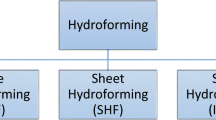Abstract
To reuse the tool paths in tool path regeneration for physical object modification in reverse engineering, this paper presented a novel CL tool path regeneration algorithm based on the CL tool path generated from the measured data points. When a physical part captured is modified, the new tool paths for the modified part can be regenerated efficiently by only calculating the affected CL tool paths on the modified region. With this strategy, if a measured physical part has been modified and the CL tool paths were generated directly from its corresponding digitized points, the affected CL tool paths are identified first; then, new CL tool paths are regenerated and used to replace the affected CL tool paths for a given machining accuracy δ. The tool paths not affected are maintained in the new NC-codes. For the method, only the tool paths for the modified regions need to be regenerated; thus, the tool path, which combines the original and modified tool paths, can be regenerated efficiently.
Similar content being viewed by others
References
Milroy M, Bradley C, Vickers G, Weirll J (1995) A G1 continuity of B-spline surfaces patches in reverse engineering. Comput Aided Des 27(6):471–478
Yin Z, Jiang S (2003) Automatic segmentation and approximation of digitized data for reverse engineering. Int J Prod Res 41(13):3045–3058
Fitzgibbon AW, Eggert DW, Fisher RB (1997) High-level CAD model acquisition from range image. Comput Aided Des 29(4):321–330
Varady T, Martin RR, Cox J (1997) Reverse engineering of geometric models—an introduction. CAD 29(4):255–268
Chui KL, Yu KM, Lee TC (2002) Direct tool-path generation from massive point input. Proc Inst Mech Eng, Part B: J Eng Manuf 216(2):199–206
Lin AC, Liu HT (1998) Automatic generation of NC cutter path from massive data points. Comput Aided Des 30(1):77–90
Park SC, Chung YC (2003) Tool path generation from measured data. Comput Aided Des 35:467–475
Chui KL, Yu KM, Lee TC (2002) Direct tool-path generation from massive point input. Proc Inst Mech Eng, Part B: J Eng Manuf 216(2):199–206
Yin Z (2004) Adaptive tool path generation from measured data. Proc Inst Mech Eng, Part B: J Eng Manuf 218(1):103–111
Zhang LP, Fuh JYH, Nee AYC (2003) Tool path regeneration for mold design modification. Comput Aided Des 35(9):813–823
Milroy M, Bradley C, Vickers G (1997) Segmentation of a warp-around model using an active contour. Comput Aided Des 29(9):299–320
Piegl L, Tiller W (1995) The NURBS book. Springer, Berlin Heidelberg New York
Lee Y-S, Chang T-C (1995) 2-phase approach to global tool interference avoidance in 5-axis machining. Comput Aided Des 27(10):129–715
Glaeser G, Wallner J, Pottmann H (1999) Collision-free 3-axis milling and selection of cutting tools. Comput Aided Des 31(3):215–233
Yang DCH, Han Z (1999) Interference detection and optimal tool selection in 3-axis NC machining of free-form surfaces. Comput Aided Des 31(5):303–315
Seiler A, Balendran V, Sivayoganathan K (1997) Tool interference detection and avoidance based on offset nets. Int J Mach Tools Manuf 37(5):717–722
Ho S, Sarma S, Adachi Y (2001) Real-time interference analysis between a tool and an environment. Comput Aided Des 33(13):935–947
Ding XM, Fuh JYH, Lee KS (2001) Interference detection for 3-axis mold machining. Comput Aided Des 33(8):561–569
Kim KI, Kim K (1995) A new machine strategy for sculpture surface using offset surface. Int J Prod Res 33(6):1683–1697
Farouki RT (1986) The approximation of non-degenerate offset surfaces. Comput Aided Geom Des 3(1):15–43
Tiller W, Hanson EG (1984) Offset a two-dimensional profiles. IEEE Comput Graph Appl 4(9):61–69
Hoschek J (1985) Offset curves in the plane. Comput Aided Des 17(2):77–82
Aomura S, Uehara T (1990) Self-intersection of an offset surface. Comput Aided Des 22(7):417–422
Barnhill RE, Farin G, Jordan M, Piper BR (1987) Surface/surface intersection. Comput Aided Geom Des 4(1):3–16
Barnhill RE, Kersey SN (1990) A marching method for parametric surface/surface intersection. Comput Aided Geom Des 7(3):257–280
Choi BK, Lee CS, Hwang JS, Jun CS (1988) Compound surface modeling and machining. Comput Aided Des 20(3):127–136
Author information
Authors and Affiliations
Corresponding author
Rights and permissions
About this article
Cite this article
Peng, Y.H., Yin, Z.W. Direct tool path regeneration for physical object modification from digitized points in reverse engineering. Int J Adv Manuf Technol 33, 1204–1211 (2007). https://doi.org/10.1007/s00170-006-0562-y
Received:
Accepted:
Published:
Issue Date:
DOI: https://doi.org/10.1007/s00170-006-0562-y




